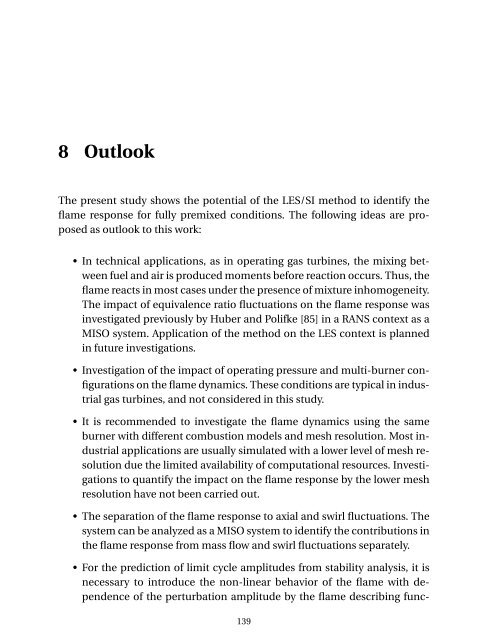Numerical Simulation of the Dynamics of Turbulent Swirling Flames
Numerical Simulation of the Dynamics of Turbulent Swirling Flames
Numerical Simulation of the Dynamics of Turbulent Swirling Flames
Create successful ePaper yourself
Turn your PDF publications into a flip-book with our unique Google optimized e-Paper software.
8 Outlook<br />
The present study shows <strong>the</strong> potential <strong>of</strong> <strong>the</strong> LES/SI method to identify <strong>the</strong><br />
flame response for fully premixed conditions. The following ideas are proposed<br />
as outlook to this work:<br />
• In technical applications, as in operating gas turbines, <strong>the</strong> mixing between<br />
fuel and air is produced moments before reaction occurs. Thus, <strong>the</strong><br />
flame reacts in most cases under <strong>the</strong> presence <strong>of</strong> mixture inhomogeneity.<br />
The impact <strong>of</strong> equivalence ratio fluctuations on <strong>the</strong> flame response was<br />
investigated previously by Huber and Polifke [85] in a RANS context as a<br />
MISO system. Application <strong>of</strong> <strong>the</strong> method on <strong>the</strong> LES context is planned<br />
in future investigations.<br />
• Investigation <strong>of</strong> <strong>the</strong> impact <strong>of</strong> operating pressure and multi-burner configurations<br />
on <strong>the</strong> flame dynamics. These conditions are typical in industrial<br />
gas turbines, and not considered in this study.<br />
• It is recommended to investigate <strong>the</strong> flame dynamics using <strong>the</strong> same<br />
burner with different combustion models and mesh resolution. Most industrial<br />
applications are usually simulated with a lower level <strong>of</strong> mesh resolution<br />
due <strong>the</strong> limited availability <strong>of</strong> computational resources. Investigations<br />
to quantify <strong>the</strong> impact on <strong>the</strong> flame response by <strong>the</strong> lower mesh<br />
resolution have not been carried out.<br />
• The separation <strong>of</strong> <strong>the</strong> flame response to axial and swirl fluctuations. The<br />
system can be analyzed as a MISO system to identify <strong>the</strong> contributions in<br />
<strong>the</strong> flame response from mass flow and swirl fluctuations separately.<br />
• For <strong>the</strong> prediction <strong>of</strong> limit cycle amplitudes from stability analysis, it is<br />
necessary to introduce <strong>the</strong> non-linear behavior <strong>of</strong> <strong>the</strong> flame with dependence<br />
<strong>of</strong> <strong>the</strong> perturbation amplitude by <strong>the</strong> flame describing func-<br />
139
















